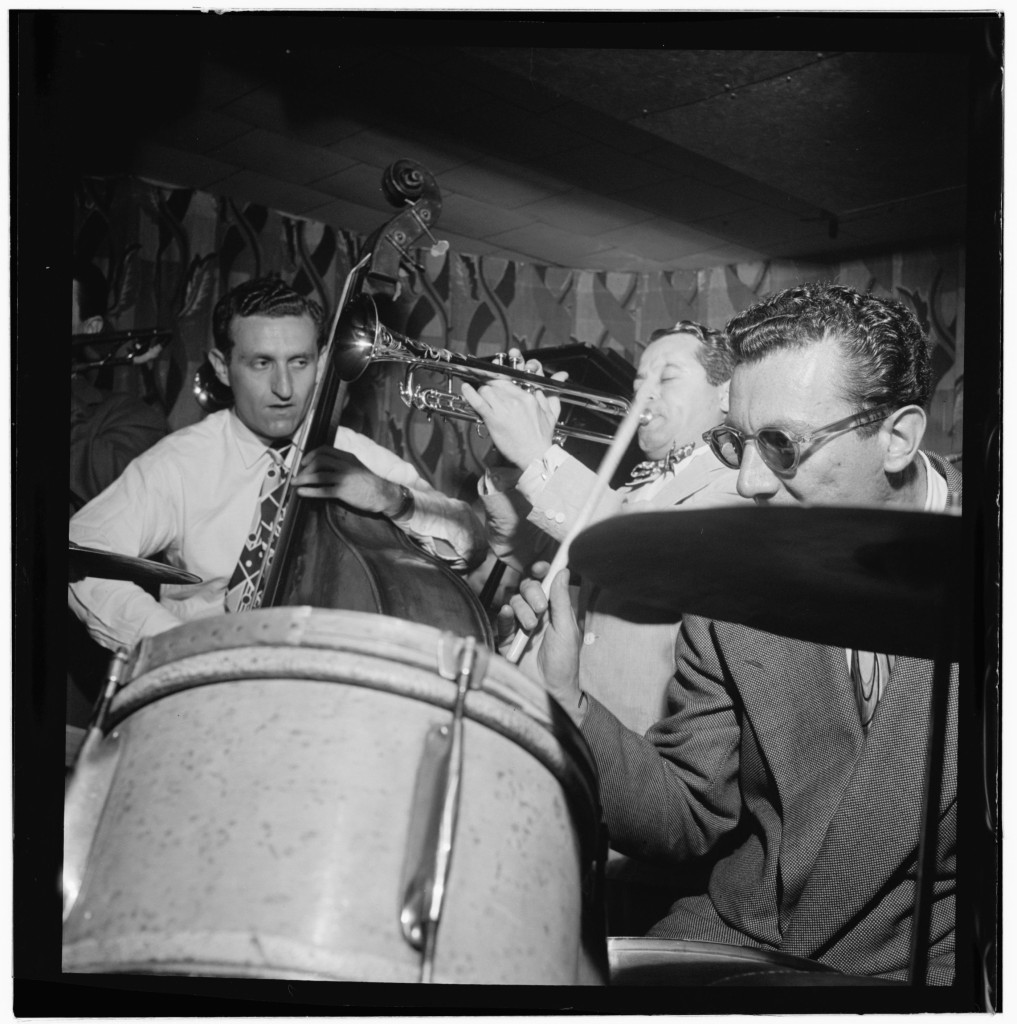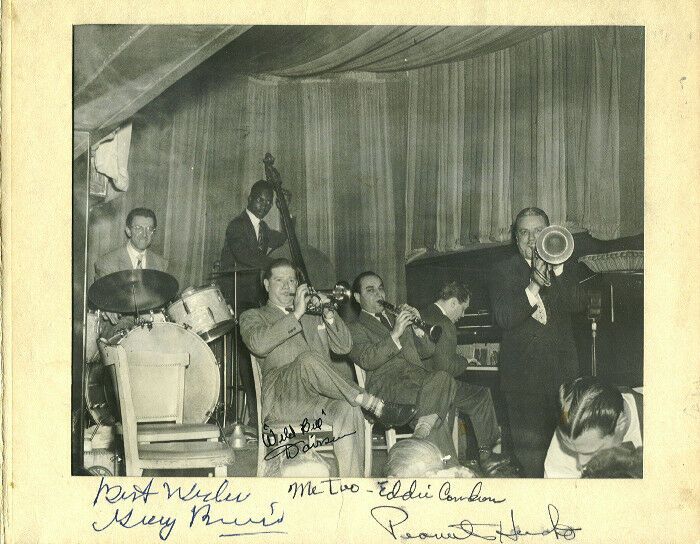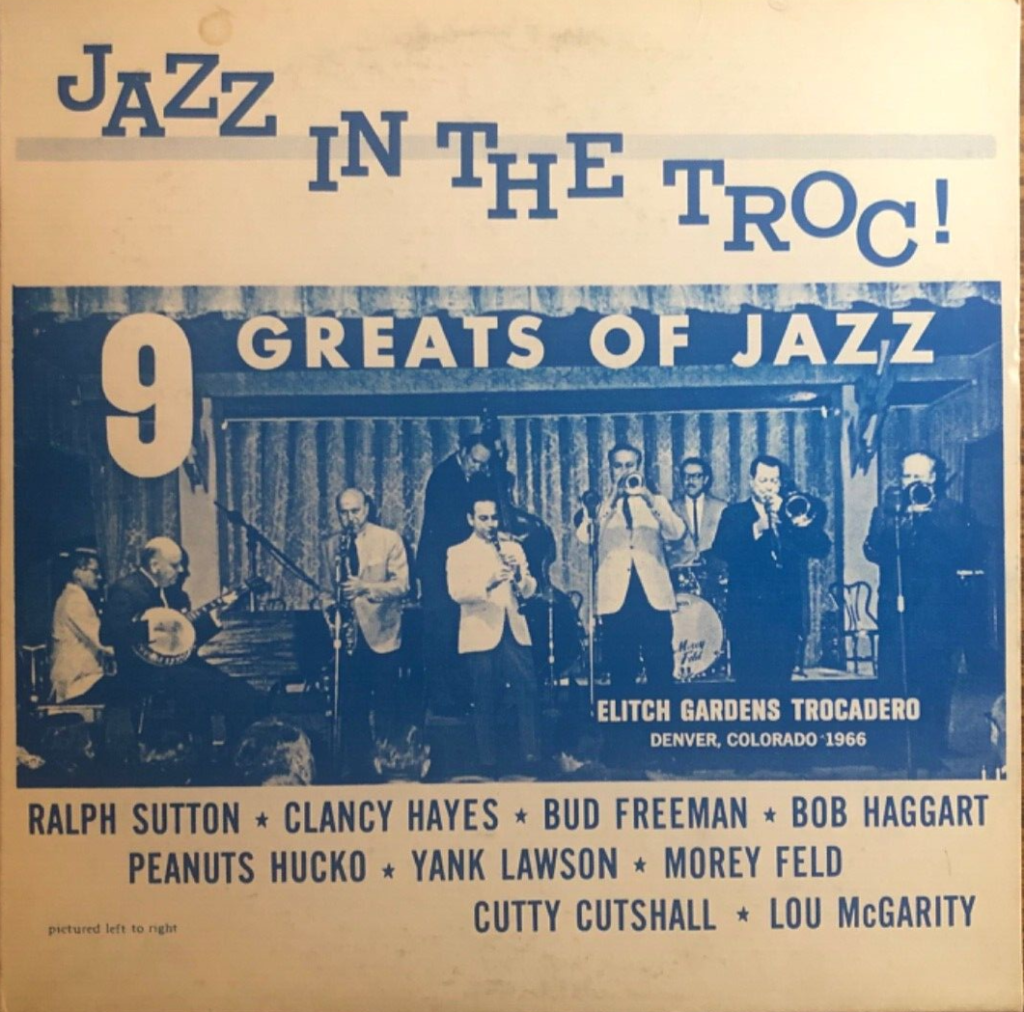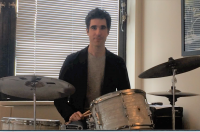Hal Smith: Well, Brother Kevin…It seems like forever since we “talked shop” for an article in The Syncopated Times. Before another year slips away, what do you say we talk about one of our favorite drummers; someone who is consistently overlooked, but deserves to be much better known? That would be Morey Feld.
We have his commercial records with Bud Freeman, Benny Goodman, Joe Bushkin, Peanuts Hucko, Slam Stewart, the World’s Greatest Jazz Band, and under his own name as well as live recordings made with Wild Bill Davison, Bobby Hackett and Pee Wee Erwin. And though many of our drum heroes seldom appeared onscreen, we can see Morey Feld play on some television programs from the 1960s which have been preserved. (In addition, one of the participants in this discussion has recorded a couple of marvelous videos illustrating the Morey Feld style of drumming).
To start off, I will mention three of Mr. Feld’s recordings from the 1940s and what catches my ear on each one. Then I would like to hear what you have to say about these sides.
First is a 1940 recording by Bud Freeman’s Summa Cum Laude Orchestra, from the “Wolverines Jazz” album. For my money, this is one of the most perfect jazz bands to ever record. From Max Kaminsky’s beautiful cornet sound to the understated timekeeping on the drums, I could listen to the SCL 24/7/365. On “Oh Baby (Don’t Say ’No,’ Say ’Maybe’)” the drums are slightly under-recorded, but the rhythm balance is wonderful. You can clearly hear Eddie Condon’s chords on the four-string guitar while Morey stays mainly with afterbeats on the snare drum, some closed hi-hats and sticks on what sounds to me like the bass drum shell. When he plays rimshots, there is a terrific-sounding resonance in the snare drum.
You might like to mention one of the sides he made in 1945 with the Benny Goodman Sextet, but I’ll skip ahead to 1947 and a transcription session with Peanuts Hucko’s group playing “The Song Is Ended.” This is actually the first record by Morey Feld that caught my attention, mainly because of the relaxed rhythm feel, the steady 4/4 on the bass drum, the well-placed snare drum accents, coordination between the snare and bass drums and cymbals and the great sounds that Morey drew out of those cymbals.
The drumming on the next selection is the exact opposite of what we heard on the previous two sides. With Wild Bill Davison’s band at the 1948 “American Music Festival,” Morey is supercharged, really driving the rhythm with a solid 4/4 on the bass drum, swinging ride cymbal and hi-hats and some of the best (and cleanest) triplets I’ve ever heard on the snare drum. The brief drum solo, the breaks, the tag and those fantastic triplets on the last chorus are real eye-and-ear openers!
Now, will you please share your thoughts on these three sides and choose some more recordings that we can discuss?
Kevin Dorn: Brother Hal! What a treat to discuss the great Morey Feld with you! Not enough people know about this true master of the drums.

You picked some wonderful tunes. It’s true that the drums aren’t very well recorded on “Oh Baby,” but the feel is so great. Sometimes people might be discouraged from listening to older recordings where one can’t hear the drums that clearly, but we can still learn so much just from getting into the feel. When Morey Feld goes to the closed hi-hat for the piano solo, we get to hear one of the things that made him so great and something we will continue to hear on his later recordings. I wonder if you agree, but I find it very difficult to play the closed hi-hat. It can sound thin and can lack the beauty of an open or open and closed hi-hat. It’s hard to get a full, driving sound. But Morey Feld always got such a great sound and feel on the closed hi-hat that he could really drive a band with it. As you say, he gets a beautiful sound from his snare drum as well and this is another thing we will hear throughout his career. When he plays on the bass drum shell, it’s something that we rarely hear him do, but it reminds us that our favorite drummers could do so many things.
“The Song Is Ended” gives us what I would call the classic Morey Feld style. Relaxed, yet driving with a powerful bass drum beat and a great cymbal sound. I love the way he changes up the rhythm on the ride cymbal. The accents he plays on the snare drum with his left hand are another important aspect of his style and he puts them in unexpected places. He also plays a lot of little buzz roll accents or drags with his left hand, which I don’t hear a lot of other drummers of this era doing. I feel his playing on this recording could go with anything, meaning you could put almost any jazz musician of any style or era on top of it and it would swing.
These elements of his style are also evident on “Clarinet Marmalade.” The figures he plays between the snare drum and bass drum remind me of Sid Catlett, Buddy Rich, and even Max Roach. Not a lot of drummers were playing this way at this point in time. He also throws in what I would call a classic Gene Krupa/Chick Webb lick between the bass drum and cymbal. But all of it sounds like Morey Feld. It sounds to me as if he’s playing a minimal set here with no tom toms. The fast, powerful triplets that he plays are incredible. He had some hands! Some drummers have great technique, some drummers have a great feel and some drummers have both. Morey Feld was a drummer with both, to be sure! I really love his playing here.
Well, you read my mind about 1945, so let’s go there and hear Morey with Benny Goodman. To me, the two of them are a match made in heaven. Even though Benny always had great drummers (including Sid Catlett — and who’s better than Sid Catlett?!), I feel that Morey’s style worked so well with Goodman that I think he’s my favorite drummer to hear with Goodman after Gene Krupa. They just fit together so well. It was hard for me to choose between “Rachel’s Dream” and “Slipped Disc,” so let’s listen to them both!
On “Rachel’s Dream,” we hear some great hi-hat playing. Morey Feld is one of those drummers who could play an entire tune on the hi-hat and never have it get boring. He varies the sound he gets for different sections, going between a closed hi-hat and an open and closed sound. His driving rimshots are perfectly placed and really move things along. I also love how he leads into the last chorus by changing his hi-hat sound a few bars early. This is the kind of thing many of my favorite drummers would do. Instead of changing the sound right at the top of the chorus, he changes it a few bars early and this sets things up so beautifully.
We hear similar things on “Slipped Disc,” but I would also point out the triplet fills he plays on the hi-hat during the opening chorus. They fit so perfectly, they almost become part of the tune and again, they’re so clean and precise. Non-drummers, believe me when I tell you that this is hard to do!
If it’s OK with you, Hal, I’d like to skip ahead nine years to 1954 to a recording that I know we both love: Benny Goodman Live at Basin Street East. This is the first record I ever heard of Morey Feld and he instantly became one of my favorite drummers. I could pick any tune from this album, but we haven’t heard any of Morey’s great brush work yet, so let’s go to “The World Is Waiting For The Sunrise.”
Morey could really swing hard with brushes, which is another reason I think he fit so well with Goodman. He gets such a solid quarter note feel with the brushes, showing us that a swinging quarter note is all you need. The fact that he plays four to the bar on his bass drum at this tempo is also extraordinary. And what a beautiful bass drum sound! We should note that he’s playing a very rare drum set here, one of only four complete sets made by the great Billy Gladstone. Of course, he would sound great on any set of drums.
He plays some wonderful bass drum accents behind Mel Powell’s piano solo that are just perfectly placed. I also love how he switches from quarter notes to the “ride cymbal rhythm” for Benny’s second chorus. It really kicks things up a notch! This is something Gene Krupa would also do and there are many similarities between Krupa and Morey Feld, but Morey found his own way to do these things. I believe that he plays this fast “ride rhythm” hand-to-hand: right, left, right, as opposed to the standard way which would be all with the right hand. He would do this sometimes with sticks as well on the hi-hat on fast tunes and it’s another thing that Gene Krupa would sometimes do. Some people might call that cheating, but it gets a slightly different sound. In fact, I always wondered how he was getting this particular sound and didn’t realize he was using both hands until I saw a video of him. Using both hands gets a more powerful sound and almost becomes like a train beat. He plays a great solo chorus made up of almost entirely single strokes based off of the snare drum, with various accents on his toms and cymbals.

George Brunies at Eddie Condon’s, late 1940s.
Another thing that really struck me the first time I heard this recording is the sound of his riveted ride cymbal. The rivets have just the perfect amount of sustain. When he rides the cymbal with sticks, you can still clearly hear each beat. On this tune, when he plays an accent on the cymbal with brushes, it creates a warm sound that shimmers for a few bars and then disappears. It’s one of my favorite ride cymbals ever.
I know you also love Morey’s work with Goodman and I once heard you play a beautiful trio set in San Diego that was a tribute to this 1954 recording. What strikes you about Morey’s playing on these tunes?
HS: Your analysis on each of those songs is so detailed that I can’t add very much! I will say that you are absolutely right about how great Morey sounded alternating between open and closed hi-hats. Shades of Dave Tough on “Opus ½” with Benny Goodman. And I second your comment about those triplets on the closed hi-hats that he plays on “Slipped Disc.” I couldn’t pull that off if my life depended upon it!
On that whole 1954 “Basin Street East” session, regardless of whether it’s the full sextet or a trio, Morey’s drumming is fantastic (and that may not be strong enough to describe how great he plays). His relentless drive and swing on “World Is Waiting” and keeping the 4/4 going on the bass drum at that tempo should convince any skeptics that Morey Feld was one of the best “groovemasters” in swing.
By the way, you’re much too kind in complimenting me for that long-ago trio set in San Diego. I was sweating bullets the whole time, but am relieved to know that you picked up on my attempts to channel Morey Feld!
Let’s end this first installment with some commentary regarding Morey’s playing with the fledgling World’s Greatest Jazz Band.
 KD: The one that immediately comes to mind (and you and I have talked about it over the years) is “Stealin’ Apples.” Morey’s drive on this is just incredible. He has such a great touch that he’s able to play the ride cymbal under much of Bob Haggart’s bass solo without getting in the way. When he trades fours with Peanuts Hucko, we again get to hear his staggering technique as he moves effortlessly around the set and also plays some lightning fast single stroke triplets. But each four bars is also a distinct musical phrase.
KD: The one that immediately comes to mind (and you and I have talked about it over the years) is “Stealin’ Apples.” Morey’s drive on this is just incredible. He has such a great touch that he’s able to play the ride cymbal under much of Bob Haggart’s bass solo without getting in the way. When he trades fours with Peanuts Hucko, we again get to hear his staggering technique as he moves effortlessly around the set and also plays some lightning fast single stroke triplets. But each four bars is also a distinct musical phrase.
Another track I would like to mention is “Get Out And Get Under The Moon.” This can be a difficult tempo to swing at and Morey’s groove just bounces along. He’s both relaxed and driving at the same time. He also truly had his own style, distinct from all of our other favorite drummers. On this entire album, his playing is so timeless and swinging that Bob Haggart is able to switch back and forth between playing in 2 and playing in 4 and it all works perfectly over what Morey is doing. I love that!
What do you take away from these 1966 recordings and do you have any favorite tracks?
HS: The ride cymbal playing on these performances, the rock-steady tempos and the solid 4/4 on the bass drum are elements you can hear on almost all of Morey’s recordings. That great pulse, as you pointed out, allows Bob Haggart to alternate between two beat and four beat with no loss of intensity.
The drum tag on “Get Out And Get Under The Moon” incorporates the wonderful, cleanly-played triplets that we associate with his drumming.
Morey Feld used two techniques that I generally dislike, but in his hands — they sound good! One is laying the left stick across the snare drum, to achieve a “pop” sound rather than letting the left stick tap the snare and getting a more resonant sound. The other thing I hear a lot in Morey’s drumming is playing a cymbal crash on “4” rather than “3.” That can really kill the swing and forward momentum of a song, but Morey makes it sound exciting! You can tell he’s striking the cymbal in just the right way to extract the maximum amount of sound.
He uses both of those devices to good advantage on “Big Noise From Winnetka.” Notice he starts off with the stick across the snare and playing ride cymbal, with Latin rhythms on the snare and cymbal dome in the exchanges with Bob Haggart. Staying on the higher-pitched percussion instruments instead of the customary tom-toms allows the string bass to be heard more clearly. We can easily hear that Morey was very familiar with this number, as he accents many of the same melodic phrases as Haggart. The drum solo before moving the sticks to the bass strings is really impressive. I wish I could watch how and what he played while moving across the drum set to the “G” string of the bass! His stick work on the bass string is incredibly clean, and that’s difficult to do. After a restatement of the initial theme, with Haggart fingering the melody, Morey wraps up the performance with a brief flourish on the snare and a definitive cymbal crash.
I’ve gone on a little bit long here, but I would really like to know your thoughts about this version of “Big Noise.”
KD: Great analysis, Hal! I completely agree that Morey is able to break the “rules” and pull things off that would sound terrible in lesser hands. In his “Big Noise” solo, there are times when his playing sounds almost more like psychedelic rock than traditional jazz, but he makes it work! I love how he will play something on the snare drum and then answer himself with a similar phrase played on either a tom tom or the hi-hat. He doesn’t do many of the things that we usually hear drummers play in this piece; for instance, he never goes to the rims, which is a very standard thing to do on this tune. He continually shows us that there’s more than one way to approach this music. The fact that he’s able to play so powerfully and still not overpower the bass is impressive. He also gets a great effect by breaking up patterns between different parts of the drumset, like keeping one hand on the cymbal while moving the other hand around the drums. Throughout, he projects an incredible amount of energy.
I would just like to take a moment to thank the late drummer Jay Duke for first telling me about these particular recordings and my friend David Ostwald, the wonderful tuba player, for copying them on cassette for me many years ago.
Hopefully these recordings will give people a good idea of what made Morey Feld so special and why you and I admire his playing so much. As always, it’s a great treat and also an educational experience to talk drums with you!
Is there anything further we should add before ending Part One of our discussion?
HS: Let’s just encourage the readers of The Syncopated Times to check out the wide variety of Morey Feld’s recordings that are available via YouTube and the Internet Archive.
I’m really looking forward to the next article; a discussion of some films where we can see Morey Feld play as well as the instructional videos by our New York correspondent which perfectly illustrate the elements which make up his unique drumming style.
Thanks for your invaluable analysis, Brother Kevin. See you in the next issue!
Hal Smith is an Arkansas-based drummer and writer. He leads the El Dorado Jazz Band and the
Mortonia Seven and works with a variety of jazz and swing bands. Visit him online at
halsmithmusic.com
Kevin Dorn is familiar to our readers as a much-in-demand jazz drummer based in the NYC area. Find him on the web atwww.kevindorn.com
























